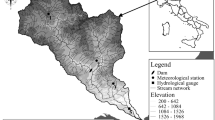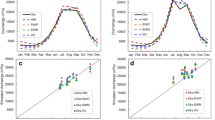Abstract
The Taoer River, a representative ecologically sensitive area in Northeast China, has undergone great climate changes and rapid social developments since 1961. Subsequently, a substantial alteration of the streamflow regime was observed and severe eco-environmental problems were becoming prominent. To provide decision makers the scientific basis for effective resource management and sound future planning, it is crucial to understand and assess the impacts of the climate variability and human activities on streamflow in this region. In this study, we combined an observation-based statistical analysis and physical modeling experiments to address this broad question. The Mann–Kendall and Sen’s slope were used to examine the trends and the moving t test was used to identify change points for the streamflow, precipitation, and potential evapotranspiration datasets. A statistically significant upward trend (α = 5 %) was found for annual streamflow. An abrupt change point was identified in 1985 for the basin outlet station at Taonan. Accordingly, the streamflow was divided into baseline and changed period for attribution analysis. To investigate the impacts of climate change and human activities on annual streamflow, we applied a distributed hydrological model and six Budyko-type functions during the two periods. The results indicated that climate change and human activities accounted for about 45 and 55 % of the changes in streamflow, respectively.







Similar content being viewed by others
References
Arnold JG, Allen PM (1996) Estimating hydrological budgets for three Illinois watersheds. J Hydrol 176:55–77. doi:10.1016/0022-1694(95)02782-3
Arnold JG, Srinivasan RS, Muttiah (1998) Large-area hydrologic modeling and assessment: part I. Model development. J Am Water Resour Assoc 34(1):73–89
Allen RG, Pereira LS, Raes D (1998) Crop evapotranspiration—guidelines for computing crop water requirements. FAO Irrigation and Drainage Paper 56 Rome Italy
Budyko MI (1948) Evaporation under natural conditions. Translated from Russian by Isr. Program for Sci. Transl. staff, Isr. Program for Sci. Transl., Jerusalem
Budyko MI (1974) Climate and life. Academic, San. Diego, CA
Changnon SA, Demissie M (1996) Detection of changes in streamflow and floods resulting from climate fluctuations and land use-drainage changes. Clim Chang 32(4):411–421
Ficklin DL, Luo Y, Luedeling E (2009) Climate change sensitivity assessment of a highly agricultural watershed using SWAT. J Hydrol 374:16–29
Dooge JC, Bruen M, Parmentier B (1999) A simple model for estimating the sensitivity of runoff to long-term changes in precipitation without a change in vegetation. Adv Water Resour 23:153–163
Dunn SM, Mackay R (1995) Spatial variation in evapotranspiration and the influence of land use on catchment hydrology. J Hydrol 171:49–73
Du JK, Rui HY, Zuo TH, Li Q (2013) Hydrological simulation by swat model with fixed and varied parameterization approaches under land use change. Water Resour Manage 27:2823–2838
Frederick KD, Gleick PH (1999) Water and global climate change: potential impacts on U.S. water resources, Pew Cent. On Global Clim. Change, Arlington, Va.48
Fu BP (1981) On the calculation of the evaporation from land surface (in Chinese). Sci Atmos Sin 5:23–31
Gassman PW, Reyes MR, Green CH (2007) The soil and water assessment tool: historical development, applications, and future research directions. Trans Am Soc Agric Biol Eng 50(4):1211–1250
Gedney N et al (2006) Detection of a direct carbon dioxide effect in continental river runoff records. Nature 439:835–838
Guo H, Hu Q, Jiang T (2008) Annual and seasonal streamflow responses to climate and land-cover changes in the Poyang Lake basin, China. J Hydrol 355:106–122
Greene EM, Liston GE, Pielke RAS (1999) Relationships between landscape, snowcover depletion, and regional weather and climate. Hydrol Process 13:2453–2466
Hendersen-Sellers A, Dickinson RE, Durbidge TB (1993) Tropical deforestation: modeling local to regional scale climate change. J Geophys Res 98:7289–7315
Hirsch RM, Slack JR, Smith RA (1982) Techniques of trend analysis for monthly water quality data. Water Resour Res 18:107–121
Jiang DJ (2007) Influence of climate change and land use/land cover change on runoff in the middle and upper reaches of Taoerhe River Basin. Ph.D. dissertation, Graduate University of Chinese Academy of Sciences, Beijing (in Chinese)
Jones JA, Post DA (2004) Seasonal and successional streamflow response to forest cutting and regrowth in the northwest and eastern United States. Water Resour Res 40:052031–0520319
Koster RD, Suarez MJ (1999) A simple framework for examining the interannual variability of land surface moisture fluxes. J Clim 12:1911–1917
Li B, Li LJ, Yuchu Q et al (2011) Impacts of climate variability on streamflow in the upper and middle Reaches of the Taoer River based on the Budyko hypothesis. Resour Sci 33(1):70–76
Liu CM, Li DF, Tian Y, Hao FH, Yang GL (2003) An application study of DEM based distributed hydrological model on macroscale watershed. Prog Geogr 22(5):437–445
Li LJ, Li B, Liang LQ (2010a) Effect of climate change and land use on stream flow in the upper and middle reaches of the Taoer River, northeastern China. For Stud China 12(2):1–9
Lioubimtseva E, Cole R, Adams JM, Kapustin G (2005) Impacts of climate and land-cover changes in arid lands of Central Asia. J Arid Environ 62(2):285–308
Li ZL, Shao QX, Xu ZX, Cai XT (2010b) Analysis of parameter uncertainty in semi-distributed hydrological models using bootstrap method: a case study of SWAT model applied to Yingluoxia watershed in northwest China. J Hydrol 385:76–83
Li Z, Liu WZ, Zhang XC, Fl Z (2009) Impacts of land use change and climate variability on hydrology in an agricultural catchment on the Loess Plateau of China. J Hydrol 377:35–42
Matheussen B, Kirschbaum RL, Goodman IA, O’Donnell GM, Lettenmaier DP (2000) Effects of land cover change on streamflow in the interior Columbia River basin (USA and Canada). Hydrol Process 14:867–885
Mao D, Cherkauer KA (2009) Impacts of land-use change on hydrologic responses in the Great Lakes region. J Hydrol 374(1–2):71–92
Ma X, Xu JC, Luo Y et al (2009) Response of hydrological processes to land-cover and climate changes in Kejie watershed, South-west China. Hydrol Process 23:1179–1191
Ma ZM, Kang SZ, Zhang L, Tong L, Su XL (2008) Analysis of impacts of climate variability and human activity on streamflow for a river basin in arid region of northwest China. J Hydrol 352(3–4):239–249
Milly PC, Dunne KA (2002) Macroscale water fluxes 2. Water and energy supply control of their inter-annual variability. Water Resour Res 38(10):241–249
Nandakumar N, Mein RG (1997) Uncertainty in rainfall-runoff model simulations and the implications for predicting the hydrologic effects of land-use change. J Hydrol 192:211–232
Niehoff D, Fritsch U, Bronstert A (2002) Land-use impacts on storm–runoff generation: scenarios of land-use change and simulation of hydrological response in a meso-scale catchment in SW-Germany. J Hydrol 267:80–93
Neitsch SL, Arnold JG, Kiniry JR, Srinivasan R (2004) Soil and Water Assessment Tool Input / Output File Documentation. Ver. 2005. Temple, Tex.: USDA–ARS Grassland Soil and Water Research Laboratory
Ol’dekop EM (1911) On evaporation from the surface of river basins:Transactions on Meteorological Observations, Lur-evskogo (in Russian). Report Univ. of Tartu, Tartu, Estonia
Partal T, Kahya E (2006) Trend analysis in Turkish precipitation data. Hydrol Process 209:2011–2026
Prowse TD (2006) Climate change, flow regulation and land-use effects on the hydrology of the Peace-Athabasca-Slave system; findings from the northern rivers ecosystem initiative. Environ Monit Assess 113:167–197
Pielke RA, Avissar R (1990) Influence of landscape structure on local and regional climate. Landsc Ecol 4:133–155
Ritchie JT (1972) Model for predicting evaporation from a row crop with incomplete cover. Water Resour Res 8:1204–1213
Saxton KE, Willey PH (2005) Soil water characteristics hydraulic properties calculator. Available from http://www.bsyse.wsu.edu/saxton/soilwater
Schreiber P (1904) Uber die Beziehungen zwischen dem Niederschlag und der Wasserfu¨hrung der Fluße in Mitteleuropa. Z Meteorol 21(10):441–452
Sen PK (1968) Estimates of the regression coefficient based on Kendall’s tau. J Am Stat Assoc 63:1379–1389
Turc L (1954) Le bilan d’eau des sols. Relation entre la pre´cipitation, l’e´vaporation et l’e´coulement. Ann Agron 5:491–569
VanShaar JR, Haddeland I, Lettenmaier DP (2002) Effects of land-cover changes on the hydrological response of interior Columbia river basin forested catchments. Hydrol Process 16:2499–2520
Van Dam JC (1999) Impacts of climate change and climate variability on hydrologic regimes. Cambridge Univ, Press New York
Van Griensven A, Meixner T, Grunwald S, Bishop T, Diluzio A, Srinivasan R (2006) A global sensitivity analysis tool for the parameters of multi-variable catchment models. J Hydrol 324:10–23
Wang GX, Liu CM, Huang YB (2003) The theory of SWAT model and its application in Heihe Basin. Process Geogr 22:79–86
Wang L et al (2010) Settlement extraction in the North China Plain using Landsat and Beijing-1 multispectral data with an improved watershed segmentation algorithm. Int J Remote Sens 31(6):1411–1426
Wei FY (1999) Statistical techniques of modern climatic diagnosis and forecasting. China Meteorological Press, Beijing, pp 63–65, in Chinese
Wigley TML, Jones PD (1985) Influences of precipitation changes and direct CO2 effects on streamflow. Nature 314:149–152
Xu ZX, Takeuchi K, Ishidaira H (2003) Monotonic trend and step changes in Japanese precipitation. J Hydrol 279(1–4):144–150
Yang D, Sun F et al (2007) Analyzing spatial and temporal variability of annual waterenergy balance in nonhumid regions of China using the Budyko hypothesis. Water Resour Res 43, W04426. doi:10.1029/2006WR005224
Yuchu Qin, Bin Li, et al. (2011) Stepwise Decomposition and Relative Radiometric Normalization for Small Footprint LiDAR Waveform. SCIENCE CHINA Earth Sciences. doi: 10.1007/s11430-010-4120-y
Zhang L, Dawes W, Walker G (2001) Response of mean annual evapotranspiration to vegetation changes at catchment scale. Water Resour Res 37:701–708. doi:10.1029/2000WR900325
Zheng H, Zhang L, Zhu R (2009) Responses of streamflow to climate and land surface change in the headwaters of the Yellow River Basin. Water Resources Research. 45,W00A19.doi:10.1029/2007WR006665
Zhang X, L Zhang, J Zhao, P Rustomji, and P. Hairsine (2008) Responses of streamflow to changes in climate and land use/cover in the Loess Plateau, China. Water Resour. Res. 44, W00A07. doi:10.1029/2007WR006711
Zhang XS, Srinivasan R, Bosch D (2009) Calibration and uncertainty analysis of the SWAT model using Genetic Algorithms and Bayesian Model Averaging. ARTICL 374(3–4):307–317
Acknowledgments
This work is supported jointly by the Project of Natural Science Fund of China (41171286), the National Basic Research Program of China (2010CB428403 and 2010CB950904), the Knowledge Innovation Program (KZCX2-YW-326-1), and the 100 Talents Program of the Chinese Academy of Sciences.
Author information
Authors and Affiliations
Corresponding author
Rights and permissions
About this article
Cite this article
Li, B., Su, H., Chen, F. et al. Separation of the impact of climate change and human activity on streamflow in the upper and middle reaches of the Taoer River, northeastern China. Theor Appl Climatol 118, 271–283 (2014). https://doi.org/10.1007/s00704-013-1032-8
Received:
Accepted:
Published:
Issue Date:
DOI: https://doi.org/10.1007/s00704-013-1032-8




